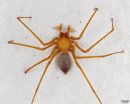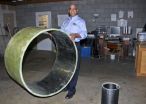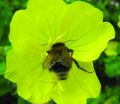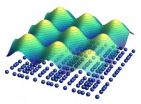(Press-News.org) The forests of the coastal regions from California to British Columbia are renowned for their unique and ancient animals and plants, such as coast redwoods, tailed frogs, mountain beavers and the legendary Bigfoot (also known as Sasquatch). Whereas Bigfoot is probably just fiction, a huge, newly discovered spider is very real. Trogloraptor (or "cave robber") is named for its cave home and spectacular, elongate claws. It is a spider so evolutionarily special that it represents not only a new genus and species, but also a new family (Trogloraptoridae). Even for the species-rich insects and arachnids, to discover a new, previously unknown family is an historic moment. A study of the new family and its evolutionary and conservation significance was published in the open access journal Zookeys.
A team of citizen scientists from the Western Cave Conservancy and arachnologists from the California Academy of Sciences found these spiders living in caves in southwest Oregon. Colleagues from San Diego State University found more in old-growth redwood forests. Charles Griswold, Curator of Arachnology, Joel Ledford, postdoctoral researcher, and Tracy Audisio, graduate student, all at the California Academy of Sciences, collected, analyzed, and described the new family. Audisio's participation was supported by the Harriet Exline Frizzell Memorial Fund and by the Summer Systematics Institute at the Academy, which is funded by the National Science Foundation.
Trogloraptor hangs beneath rudimentary webs on cave ceilings. It is about four centimeters wide when its legs are extended—larger than the size of a half-dollar coin. Their extraordinary, raptorial claws suggest that they are fierce, specialized predators, but their prey and attack behavior remain unknown.
The anatomy of Trogloraptor forces arachnologists to revise their understanding of spider evolution. Strong evidence suggests that Trogloraptor is a close relative of goblin spiders, but Trogloraptor possesses a mosaic of ancient, widespread features and evolutionary novelties.
The true distribution of Trogloraptor remains unknown: that such a relatively large, peculiar animal could elude discovery until 2012 suggests that more may be lurking in the forests and caves of western North America.
INFORMATION:
Original source:
Griswold CE, Audisio T, Ledford JM (2012) An extraordinary new family of spiders from caves in the Pacific Northwest (Araneae, Trogloraptoridae, new family). ZooKeys 215: 77-102. doi: 10.3897/zookeys.215.3547
Posted by Pensoft Publishers.
Spider version of Bigfoot emerges from caves in the Pacific Northwest
2012-08-17
ELSE PRESS RELEASES FROM THIS DATE:
Trained NHS therapists can help insomniacs
2012-08-17
Insomnia sufferers in England could have greater access to successful treatment, thanks to a training programme developed as part of trials of Cognitive Behaviour Therapy for Insomnia (CBTi), funded by the Economic and Social Research Council (ESRC).
In Britain, people report having insomnia more often than any other psychological condition, including anxiety, depression and even pain, according to the Office of National Statistics. Yet the only treatment offered in most doctors' surgeries is a course of sleeping tablets.
"It is well known that sleeping pills can be ...
UA engineering professor uses aerospace materials to build endless pipeline
2012-08-17
TUCSON, Ariz. (August 17, 2012) -- Mo Ehsani, Professor Emeritus of Civil Engineering at the University of Arizona, has designed a new, lightweight underground pipe he says could transform the pipeline construction industry.
Instead of conventional concrete or steel, Ehsani's new pipe consists of a central layer of lightweight plastic honeycomb, similar to that used in the aerospace industry, sandwiched between layers of resin-saturated carbon fiber fabric.
In combination, these materials are as strong, or stronger, than conventional steel and concrete pipes, which ...
It must be important but what does it do? The strange case of UCP2
2012-08-17
When uncoupling proteins are active, mitochondria produce heat instead of ATP. This may be useful under certain circumstances, such as when an animal is hibernating. But non-hibernating animals also have them. Particularly poorly understood is the uncoupling protein UCP2. Elena Pohl and colleagues at the University of Veterinary Medicine, Vienna, show that the protein occurs mainly in cells of the immune system. The group's highly provocative findings are published in the online journal PLOS ONE.
Mitochondria represent the powerhouses of the eukaryotic cell. They ...
Iconic Darwin finch genome sequenced in Genome 10K international collaboration
2012-08-17
Santa Cruz, California—Scientists have sequenced the genome of one of the iconic Galapagos finches first described by Charles Darwin. The genome of the medium ground finch (Geospiza fortis) is among the first of a planned 100 genomes of vertebrate species to be sequenced and released by an international collaboration between the Genome 10K project and BGI.
This finch genome, the first of the BGI-Genome 10K collaboration to be made available through the UCSC Genome Browser, represents both a scientific and a symbolic advancement, according to Duke University associate professor ...
Magnetic turbulence trumps collisions to heat solar wind
2012-08-17
New research, led by University of Warwick physicist Dr Kareem Osman, has provided significant insight into how the solar wind heats up when it should not. The solar wind rushes outwards from the raging inferno that is our Sun, but from then on the wind should only get cooler as it expands beyond our solar system since there are no particle collisions to dissipate energy. However, the solar wind is surprisingly hotter than it should be, which has puzzled scientists for decades. Two new research papers led by Dr Osman may have solved that puzzle.
Turbulence pervades ...
Wild pollinators support farm productivity and stabilize yield
2012-08-17
Most people are not aware of the fact that 84% of the European crops are partially or entirely dependent on insect pollination. While managed honeybees pollinate certain crops, wild bees, flies and wasps cover a very broad spectrum of plants, and thus are considered the most important pollinators in Europe.
The serious decline in the number of managed honeybees and wild bees reported in Europe over the last few decades has the potential to cause yield decreases with threats to the environment and economy of Europe. The future of the pollination services provided by bees ...
War is not necessarily the cause of post-traumatic stress disorder
2012-08-17
A large-scale survey of the mental condition of military personnel before, during and after their posting to Afghanistan has proved thought-provoking. In total, 746 Danish soldiers took part in the survey. The soldiers completed a questionnaire five times in all – before their posting, during their time in Afghanistan and three times after their return to Denmark.
Professor Dorthe Berntsen of the Center on Autobiographical Memory Research – CON AMORE, Department of Psychology, Aarhus University, Business and Social Sciences, is responsible for the study, together with ...
Photographic cholesterol test
2012-08-17
Researchers in India have developed a total cholesterol test that uses a digital camera to take a snapshot of the back of the patient's hand rather than a blood sample. The image obtained is cropped and compared with images in a database for known cholesterol levels.
Writing in the International Journal of Medical Engineering and Informatics, N.R. Shanker of the Sree Sastha Institute of Engineering and Technology and colleagues describe how they have developed a non-invasive way to test cholesterol levels in patients at increased risk of heart disease. Their approach ...
Regions vary in paying prisoners to participate in research
2012-08-17
TORONTO, Aug. 17, 2012--When members of the public participate in research studies, they are often given incentives – such as cash or gift cards for food – as compensation or reimbursement for their time and effort. Not so for Canada's prison population. A new analysis shows that there is inconsistency in how and when incentives are used for research participants under criminal justice supervision.
Of the provinces, territories and federal government, only two jurisdictions have written policy around the use of research incentives, according to a national study led by ...
Constructive conflict in the superconductor
2012-08-17
Whether a material conducts electricity without losses is not least a question of the right temperature. In future it may be possible to make a more reliable prediction for high-temperature superconductors. These materials lose their resistance if they are cooled with liquid nitrogen, which is relatively easy to handle. An international team, in which physicists of the Max Planck Institute for Solid State Research in Stuttgart played a crucial role, has now discovered that this form of superconductivity competes with charge density waves, i.e. with a periodically fluctuating ...



